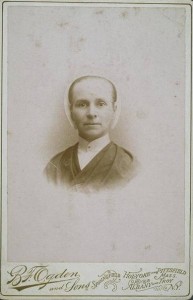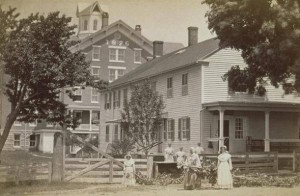By Mike Miller for Connecticut Explored
Who were the Shakers? Some consider Shakerism a religious movement, while others see the Shakers as a cult. To some, Shakerism was one of the 19th century’s more successful experiments in communal living; others know the Shakers only for the beautiful furniture they made. Countless books have been written about the Shakers, their history, their lifestyle, and their religion, but, despite this interest, few people realize that the Shakers were an important part of Enfield, Connecticut, for more than a century, or that Enfield was an important part of Shaker history. Most people are amazed to learn of the size of the Enfield community, the variety of business activities there and, perhaps most startlingly, that how we remember all Shakers is in large part a result of the Shakers’ early Enfield connection.
The Group’s Origins
The Shakers were (and continue to be) members of the United Society of Believers in Christ’s Second Appearing. “Shaker” is short for “Shaking Quakers,” originally an epithet referring to the disturbing shaking and swaying movements that overcame Believers as the Spirit entered them during their religious meetings. As the world’s view of Believers changed from shock and disdain to admiration, “Shaker” became synonymous with the Believers’ good characteristics and with the superior quality of their workmanship and products. The Believers adopted the Shaker name, using it among themselves and also as a “brand name” in their dealings with the outside world.
Shakerism was born in Manchester, England in 1747 when members of two religious groups, Quakers from England and Camisards from France, were brought together by their shared beliefs that the Second Coming of Christ was approaching and that the only way to prepare for that event was to seek a life of perfection by following the inner light of the Spirit. The newly formed group called itself the Believers. In 1758 Ann Lee, the poor wife of a Manchester blacksmith, came into contact with the Believers’ first leaders, James and Jane Wardley. Lee, who had lived a miserable life and who had experienced religious dreams and visions since her youth, found that she shared many beliefs with the Wardleys and quickly joined their group. Lee continued to have many powerful visions and was soon deemed by the Believers to be the female incarnation of Christ. In 1774, after years of abuse and harassment by non-Believers, Mother Ann, her husband Abraham Stanley (also known as Abraham Standley or Abraham Standerin), and seven other Shakers left England for America . The Wardleys remained in England with an unknown number of followers and faded into obscurity. Stanley abandoned Ann and left the Shakers shortly after arriving in New York .
The small band of Shakers settled in New York . Efforts to recruit converts were mostly unsuccessful until about 1780, when Enfield, Connecticut native Joseph Meacham, a Baptist preacher living in New Lebanon, New York, heard about the Shaker movement. He soon converted, bringing many of his own followers with him. Though he would later rise to the top of the Shaker leadership and make New Lebanon the central Shaker community in 1787, his Enfield connections planted the seed of a Shaker community there only a year after his conversion.
Violence Greets Shakers’ Early Efforts in Enfield
In 1781 Mother Ann set out on a two-year recruiting mission in New England. She visited the home of Joseph Meacham’s brother David in Enfield three times during her travels. Unfortunately, the Shakers’ religious practices and beliefs were viewed as strange and frightening-or worse-by many of “The World’s People,” as the Shakers referred to non-Believers. This fear and intolerance led to violence during the first two Enfield visits.
During Mother Ann’s first Enfield visit, in 1781, the Shakers were holding services at David Meacham’s house when a mob of townspeople broke in and threatened to tar and feather the worshippers. Whether he was sympathetic to the Shakers, more tolerant than the mob, or simply keeping the peace, local Revolutionary War veteran Elija Jones intervened and escorted Mother Ann and her followers safely out of town.
Mother Ann’s 1782 visit to Enfield met with yet more violence. Between 20 and 30 Somers men, led by Captain Charles Kibbe, broke into David Meacham’s home in pursuit of the Shakers. Enfield constable John Booth broke up the disturbance, but not before serious damage was done and the pacifist Shakers were roughed up by the angry mob. The rioters soon found themselves in court, where the Shakers asked only that the defendants confess their conduct before their own church. They refused and were tried, found guilty, and fined.
In 1783 Mother Ann visited David Meacham’s home one last time. Apparently the fines imposed on the rioters after the previous visit did the trick: although they weren’t welcomed with open arms, the Shakers this time were not assaulted or threatened. In fact, they attracted converts, laying the foundation for a Shaker community in Enfield.
Mother Ann died in 1784 from exhaustion and the residual effects of continued beatings received at the hands of hostile mobs. James Whittaker, one of the original Shakers who came from England with her, took over leadership of the Believers. He immediately began gathering the scattered Shakers-including the fledgling group in Enfield-into organized communities for their safety and mutual benefit.
Joseph Meacham Assumes Leadership
Father Whittaker died in 1787 and is buried in the Shaker cemetery in Enfield. With Whittaker’s passing, Joseph Meacham became the first American-born head of the Shakers. Father Joseph organized the existing New York and New England communities into bishoprics; later leaders would found new communities and bishoprics in the “western” states of Ohio, Indiana, and Kentucky, and even as far south as Georgia and Florida, although the southern communities were very short-lived. Under Meacham’s leadership, the Believers became The United Society of Believers in 1792. That same year the Enfield Shaker settlement was officially founded on land donated by David Meacham and named “The City of Union” by the Shakers. Enfield was placed under control of the Hancock, Massachusetts bishopric, along with Tyringham, Massachusetts. (Another, larger, Shaker community was established in Enfield, New Hampshire at about the same time, but was part of the New Hampshire bishopric and had no direct connection to Enfield, Connecticut.)
The holiest location in the Enfield settlement was Tiffany Hill, also known by the Shakers as the Mount of Olives, which overlooked the entire Shaker property. Its holiness derived from a marble monument erected at the top of the hill by the Shakers. Known as the Millennium Stone or the Fountain Stone, it was inscribed with prayers and other holy messages. There was also a warning for sinners not to approach the stone lest they find themselves judged (and presumably sent to Hell). The Shakers, who held feasts on the hill each spring and fall, believed that Jesus would appear on this stone at his Second Coming. The stone’s fate is unknown, but legend holds that it was thrown into Crescent Lake or buried somewhere near it just before the Shakers left Enfield. All attempts to find it have failed.
Father Joseph devised a forward-thinking leadership structure that, in social terms, set Shaker communities a century and more ahead of most of the world. Under his system, which all Shaker communities, including Enfield’s, followed, men and women stood as equals, sharing equally in the responsibility for running the community. Deacons and deaconesses managed the community’s material needs, while elders and eldresses attended to spiritual needs. Male and female bishops oversaw groups of communities, and trustees carried out the Believers’ dealings with the outside world. At first all trustees were male, simply because the outside world was not prepared to conduct business with women. But as females became more accepted in business dealings by the outside world-and as the number of male Shakers dwindled-women were allowed to become trustees.
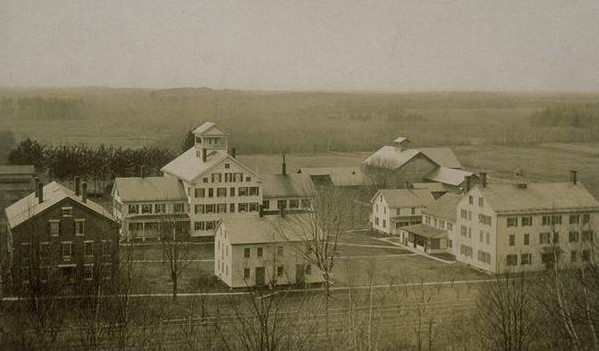
North Family Shakers in Enfield, 1900 – Connecticut Historical Society and Connecticut History Illustrated
Life in the Enfield Community
The Enfield settlement was divided into groups known as families. The Church Family was the first to be organized and had overall control of and responsibility for the Enfield settlement. The North Family was organized next, followed by the South, West, and East Families. At their peak, each family had 40 or more members and together occupied nearly 3,000 acres.
Life in the community was strictly organized, simple-and celibate. To reduce temptation, men and women lived and worked in separate buildings. When both sexes had to share a building, such as the meeting house, they used different doors and remained separate while inside. Very specific rules governed all interactions between the sexes.
Since the Shakers did not have children of their own, they had to recruit members from the outside world. In the early years, the Shaker community provided a great deal more security and comfort than did life outside. Many outsiders found the demands of the Shaker faith a small price to pay for a safe life and the communities flourished.
The Shakers took in orphans and children whose parents were unable to care for them. The children were raised and educated at Shaker expense. Upon reaching adulthood, they were free to choose whether to become Shakers or return to the outside world. Results appear to have been mixed: One Enfield widower, Seth Pease, sent his six children to live with the Enfield Shakers. Omar Pease stayed and became an elder, Clarissa an eldress, and Martha a trustee; the other three returned to the outside world.
Despite their differences with the outside world, the Enfield Shakers were known for their hospitality. Visitors were welcome to dine at the North Family. In a published account of an 1865 visit, American author and poet Joel Benton described the supper he and his companions were served: “Everything was of the most genuine and substantial make. The bread, and cake, and cheese would have taken premiums at a county fair; and they also brought forward some excellent pie, delicious canned peaches, and all the et ceteras that go to make up a sumptuous meal.” Benton also mentions the very fine Shaker-made whortleberry wine and metheglin (mead made from honey). In later years both the Church and North families sold meals to supplement their shrinking incomes. Visitors arriving by train at Shaker Station (built by the Enfield Shakers to support their businesses) or by horse were served in dining rooms advertised by postcards published and sold by the Shakers. During their visit they could purchase a variety of small items made by the Shakers. While the Shakers did not invent the “food and souvenir” tourist attraction still so popular today, they were quick to create their own “flavor” and to profit from the Victorian tourism boom.
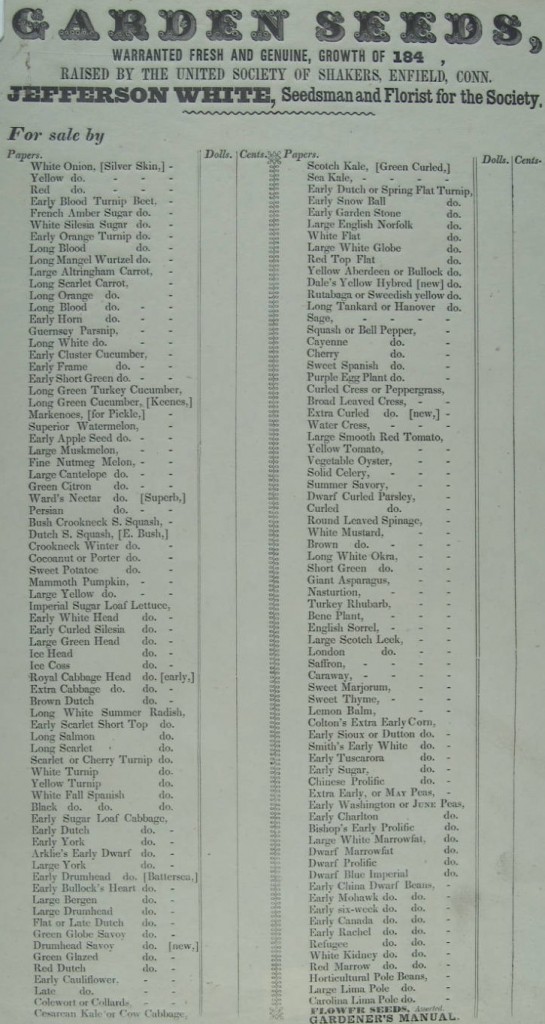
Seeds for sale by the United Society of Shakers in Enfield, 1840s – Connecticut Historical Society and Connecticut History Illustrated
Packaged Garden Seeds, a Shaker Innovation
During their early 19th-century heyday, the Enfield Shakers produced a variety of goods for their own consumption and for trade with the outside world. Among their most successful ventures was the growing and selling of garden seed. In 1802, with Brother Jefferson White’s founding of a seed business, Enfield became the first Shaker community to raise seed commercially. Enfield seed was soon sold through dealers all over the United States. A circa 1850 broadside from Georgia lists more than 100 varieties of vegetable, flower, and other seeds raised by the Shakers. And an 1835 New York City advertisement informed “the public, and Market Gardeners in particular” that E. C. & R. E. Moss, Druggists were “Agents for the Society” and that they had received their Spring supply of the justly celebrated Shaker’s Garden Seeds, comprising a full assortment, all of last year’s growth. These seeds were raised and put up with the utmost care by the Society at Enfield, Conn. and are confidently recommended as decidedly superior to those offered for sale by some dealers, which they obtain promiscuously from various sources. For sale, either in small packages, as neatly put up by the Shakers, or by weight and measure, in quantities to suit purchasers, and at prices that cannot fail to please.
The seed business’s success derived largely from two factors: the packaging of seed in packets, a Shaker innovation that still defines the garden-seed business today, and the superior quality of the seeds. Demand was so great that the Shakers found it necessary to contract with local farmers to grow seed to be sold under the Enfield Shaker label.
Not every agricultural venture was as successful. Beginning about 1815, the Enfield Shakers attempted to raise silkworms, with an eye toward making silk. The endeavor failed, but the grove of mulberry trees planted to nurture the silkworms still stood in the early 1900s. And the silkworms’ legacy may yet endure: In 1913, “four all-silk, yard square handkerchiefs from silk raised, colored and woven in the community” were included in a trunk of Enfield items donated to the Wadsworth Atheneum by Eldress Emily Copley.
The seed business fell into decline during the Civil War years and was discontinued by the 1870s. With the outbreak of the war, the Shakers could no longer legally trade with the states that had joined the Confederacy, instantly closing a large part of the market for their seed. Compounding the problem was significant uncollectible debt owed to them by Southern businesses. Perhaps also contributing to the decline of the business was the loss of the man who had run it for nearly six decades when Brother White died in 1859, just before the war. In any case, the seed business never recovered.
Other Business Ventures
Enfield Shaker businesses weren’t limited to agriculture. Manufacturing concerns included a sawmill, a hammer mill for making lead pipe, and a variety of other smaller operations, such as rug weaving. And while Enfield was not one of the communities where furniture was manufactured for sale, Enfield Shakers did make furniture. Abner Allen (1776-1855) and Thomas Fisher (1823-1902) are perhaps the most renowned of the Enfield furniture craftsmen. Both made elegant, finely crafted furniture, examples of which are found in the finest private and museum collections today. The clean and simple lines of Allen’s furniture epitomize what is known as the Shaker style of furniture, while Fisher’s style is a cross between Shaker and Victorian styles, with complex moldings, strongly contrasting woods, and elaborate leg shapes.
The Enfield Shakers invested in stocks, bonds, and real estate to bolster their income and provide for future security. These investments became particularly important in later years as the Shaker population began to age and was less able to produce goods for sale. Contrary to their charitable Christian beliefs, Shakers could be ruthless in business dealings. Some of their investments included holding the mortgages on local farms, and more than once they called in a loan when they knew the farmer could not pay, thus taking possession of a farm to expand the size of the Shaker property.
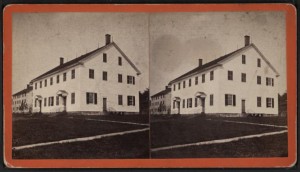
Meeting house, Shaker village, Enfield – Robert N. Dennis Collection of Stereoscopic Views at the New York Public Library Digital Gallery
Shakers Depart Enfield but Leave Rich Legacy
The Shaker movement lost momentum in the 1850s and began a slow decline as American society evolved. Industrialization–and the opportunities it created–opened new options that were more appealing than the celibate and strictly controlled Shaker lifestyle. People–young men in particular–ceased to join in any numbers. Most children raised by the Shakers left when they reached the age of choice. In Enfield, the West Family closed in 1854 and the East Family in 1874. Membership in the remaining families continued to dwindle, and those remaining had to rely increasingly on hired help to operate the farms. The North Family closed its doors in 1913, leaving only a handful of Shakers occupying some of the Church and South Family buildings. On November 24, 1914, the Shaker property was sold to John B. Stewart of Windsor, Connecticut and John Philips of Wendham, Massachusetts. The sale agreement allowed the Shakers to remain on the property for the rest of their lives, but the last three left Enfield in 1917 for other communities.
In 1931, the State of Connecticut purchased 1,400 acres of the former Shaker property to accommodate the Osborn Prison Farm. This tract included the remaining Church and North Family buildings. The full historic (and later monetary) value of the buildings and their contents was not understood at that time, and much was lost or destroyed. Only a few buildings, including the Church Family meeting house, remain today, and they have been heavily used during the nearly nine decades since the Shakers left. The presence of Department of Correction facilities on the property makes what remains inaccessible to the public, except under very rare and special circumstances. Because of security issues, even stopping to look at the buildings or cemetery from the road is prohibited. Beyond the prison properties, only the South Family dwelling and a few outbuildings remain today. Located on Cybulski Road, they are privately owned and not open to the public.
Fortunately, glimpses of Enfield’s Shaker past can be still seen among the artifacts and photographs on view at the Enfield Historical Society’s Old Town Hall and Martha Parsons House museums and at some of the larger Shaker museums including Hancock Shaker Village in Pittsfield, Massachusetts and Canterbury Shaker Village in Canterbury, New Hampshire. Enfield Shaker furniture is also in the collections of major art museums, including the Metropolitan Museum of Art in New York .
The legacy of the Enfield, Connecticut Shakers is not easy to see today, but it is an important one nonetheless. The few remaining buildings, the rare pieces of furniture and other artifacts of daily life, and the more numerous, but still uncommon photographs of the “City of Union,” are all tangible parts of this legacy. When we buy packets of garden seeds we are touched by the business genius of the Enfield Shakers. But Enfield’s Shaker legacy is far more than mere objects and marketing innovation. Enfield’s Joseph Meacham laid down the rules of organization and structure that defined how every Shaker community was organized and run. His rules allowed men and women to live together as equals in communities where everyone was cared for. He took the visions and wisdom of Mother Ann and translated them into real-world utopian communities that lasted more than a century-and that can still teach us many lessons about how we should live our lives.
Mike Miller is past president of the Enfield Historical Society and the author of the book Images of America: Enfield, Connecticut (Arcadia Publishing, 1999).
© Connecticut Explored. All rights reserved. This article originally appeared in Connecticut Explored (formerly Hog River Journal) Vol. 3/ No.3, Summer 2005.
Note: ConnecticutHistory.org does not edit content originally published on another platform and therefore does not update any instances of outdated content or language.






